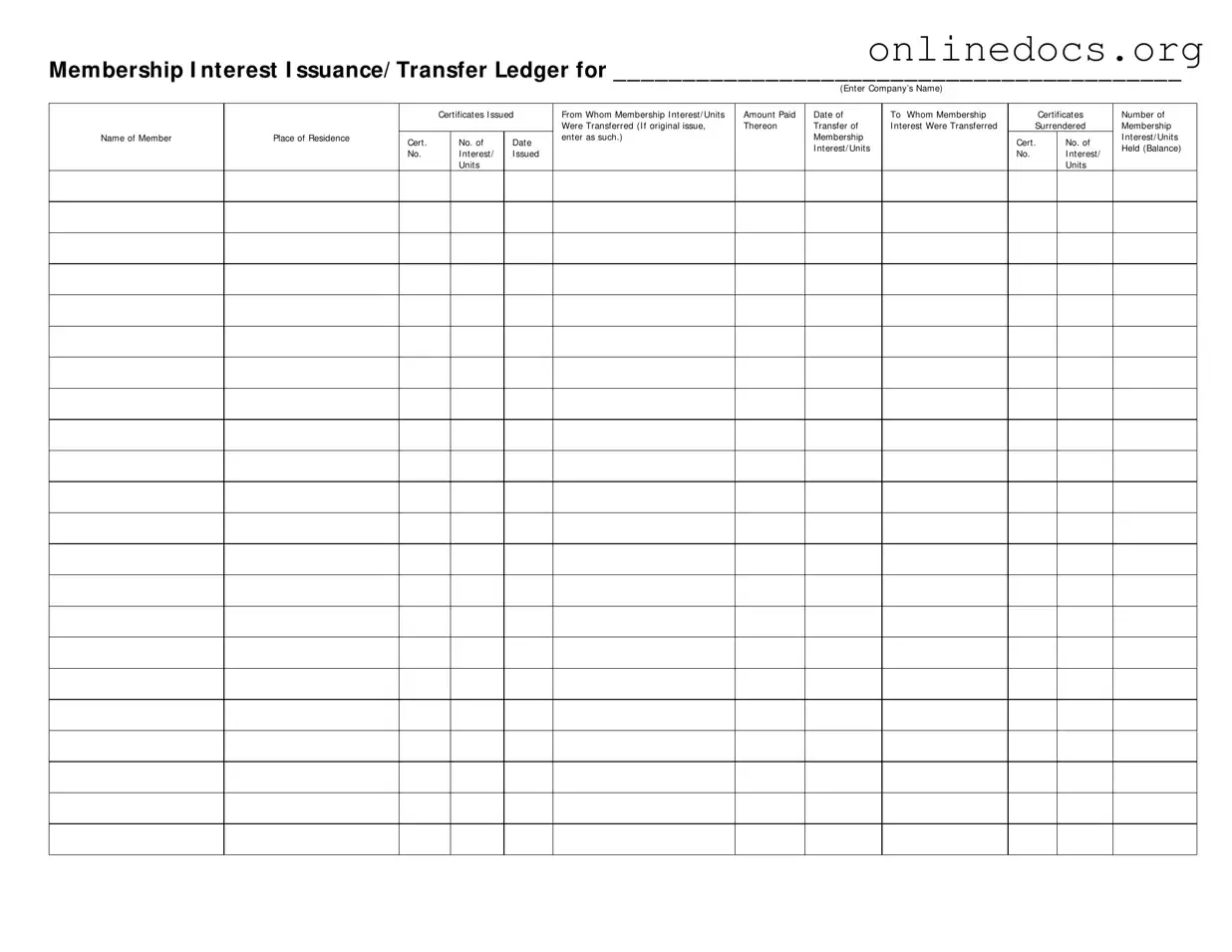The Membership Certificate is a document that represents ownership in a company or organization. Similar to the Membership Ledger, it provides essential details about the member, including their name, the number of units or shares owned, and the date of issuance. This certificate serves as proof of membership and can be transferred or surrendered, just like the entries in the Membership Ledger. Both documents help maintain accurate records of ownership and facilitate the transfer process when members decide to sell or transfer their interests.
The Shareholder Register is another document closely related to the Membership Ledger. It contains a comprehensive list of all shareholders in a corporation, detailing their ownership stakes and contact information. Like the Membership Ledger, the Shareholder Register is updated whenever shares are issued, transferred, or surrendered. This ensures that the company has an accurate record of its shareholders, which is crucial for communication and voting purposes. Both documents serve to uphold transparency and accountability within the organization.
The Transfer Ledger is specifically designed to track the transfer of ownership of shares or membership interests. This document records the details of each transaction, including the parties involved, the number of units transferred, and the date of the transfer. Similar to the Membership Ledger, it helps maintain a clear history of ownership changes. By documenting these transfers, both ledgers ensure that the organization can accurately reflect its current membership and ownership structure.
The Stock Certificate serves as tangible proof of ownership in a corporation, much like the Membership Certificate. It includes important information such as the shareholder's name, the number of shares owned, and the date of issuance. Both documents can be transferred, and when a stock certificate is surrendered, the corresponding entry in the Membership Ledger is updated to reflect the change in ownership. This connection ensures that ownership records remain consistent and reliable.
The Ownership Transfer Agreement is a legal document that outlines the terms and conditions under which ownership of shares or membership interests is transferred. This agreement complements the Membership Ledger by providing a formal record of the transfer process. While the Membership Ledger tracks the actual ownership changes, the Ownership Transfer Agreement details the specifics of the transaction, ensuring that both parties understand their rights and obligations. Together, they create a complete picture of ownership transitions.
The Membership Application is a document that individuals complete to request membership in an organization. Similar to the Membership Ledger, it collects vital information about the prospective member, such as their name, contact details, and the amount of membership interest they wish to acquire. Once approved, this information is reflected in the Membership Ledger, which helps maintain an organized record of all current members. Both documents play a crucial role in managing membership and ensuring that the organization has accurate information about its members.
Understanding the importance of proper documentation in ownership transfer extends to various contexts, including vehicles. For those looking to buy or sell a motorcycle in California, it is vital to complete the necessary forms to ensure that the ownership is legally recognized. For more information, you can visit https://fillpdf-forms.com/ to access the California Motorcycle Bill of Sale form and facilitate a smooth transaction.
The Meeting Minutes serve as an official record of discussions and decisions made during meetings of the organization’s members or board. While not directly tracking ownership, they often reference the Membership Ledger when discussing member participation and voting rights. The minutes document any decisions regarding membership changes, such as new members being admitted or existing members transferring their interests. This connection between the two documents ensures that the organization maintains a clear and consistent record of its governance and membership activities.
The Annual Report provides a comprehensive overview of an organization’s performance over the year, including financial statements and membership statistics. Similar to the Membership Ledger, it reflects the organization’s current membership status and any changes that have occurred throughout the year. The Annual Report may reference the Membership Ledger to provide insights into membership growth, retention, and overall engagement. Both documents contribute to a transparent and accountable representation of the organization’s health and direction.
